

Scientia Silvae Sinicae ›› 2023, Vol. 59 ›› Issue (10): 138-149.doi: 10.11707/j.1001-7488.LYKX20220146
• Research papers • Previous Articles Next Articles
Xiao Wang1( ),Yinli Bi1,2,*(
),Yinli Bi1,2,*( ),Yi Wang3,Ye Tian1,Qiang Li3,Xinpeng Du1,Yun Guo1
),Yi Wang3,Ye Tian1,Qiang Li3,Xinpeng Du1,Yun Guo1
Received:2022-03-17
Online:2023-10-25
Published:2023-11-01
Contact:
Yinli Bi
E-mail:dalianxiao222@163.com;ylbi88@126.com
CLC Number:
Xiao Wang,Yinli Bi,Yi Wang,Ye Tian,Qiang Li,Xinpeng Du,Yun Guo. Effects of Planting Density of Hippophae rhamnoides and Inoculation of AMF on Understory Vegetation Growth and Soil Improvement[J]. Scientia Silvae Sinicae, 2023, 59(10): 138-149.

Fig.1
Plant coverage (a) and number (b) under different mycorrhizal treatments and plant density Different uppercase letters represent significance between different mycorrhizal treatments; different lowercase letters represent significant difference between different planting density; * means significant difference between artificial reclamation area and natural recovery area(P<0.05). AM, PD, L, M, H respectively represents inoculated treatment, different planting density treatment, low planting density, intermediate planting density and high planting density."
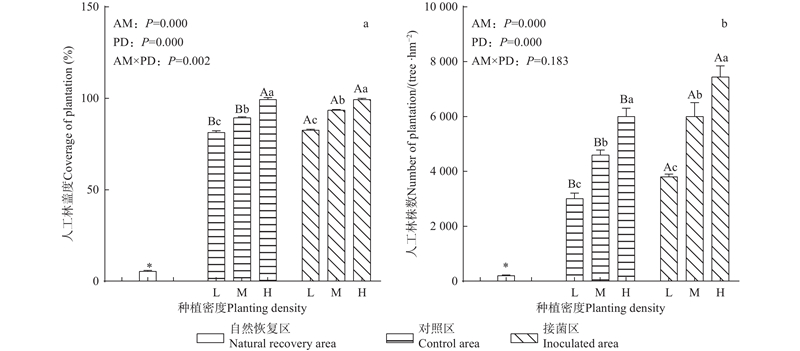

Fig.2
Understory shoot biomass (a) and coverage (b) under different mycorrhizal treatments and planting density Different uppercase letters represent significance between different mycorrhizal treatments; different lowercase letters represent significant difference between different planting density; * means significant difference between artificial reclamation area and natural recovery area(P<0.05). AM, PD, L, M, H respectively represents inoculated treatment, different planting density treatment, low planting density, intermediate planting density and high planting density."
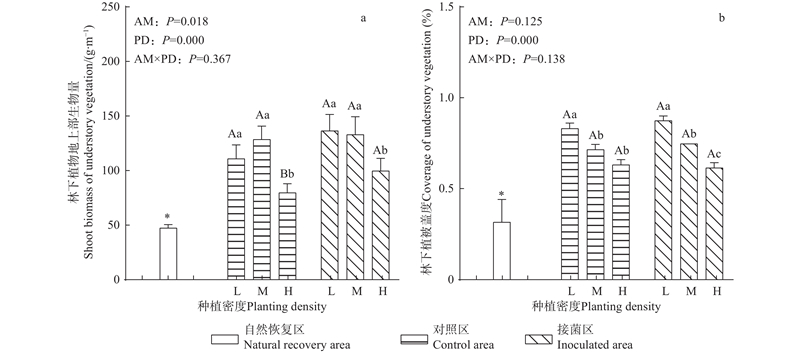
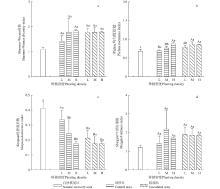
Fig.3
the α diversity indexes of understory vegetation Different uppercase letters represent significance between different mycorrhizal treatments; different lowercase letters represent significant difference between different planting density; * means significant difference between artificial reclamation area and natural recovery area(P<0.05). L, M, H respectively represents inoculated treatment, different planting density treatment, low planting density, intermediate planting density and high planting density."

Table 1
The result of two-way ANOVA analysis"
| 差异来源 Difference source | df | Shannon-Wiener指数 Shannon-Wiener index | Pielou均匀度指数 Pielou evenness index | Simpson优势度 Simpson dominance index | Margalef丰富度指数 Margalef richness index | |||||||
| F | P | F | P | F | P | F | P | |||||
| 接菌处理 Inoculum treatment (A) | 1 | 0.626 | 0.444 | 8.597 | 0.013 | 6.333 | 0.027 | 0.196 | 0.666 | |||
| 密度处理 Density treatment (B) | 2 | 1.232 | 0.326 | 15.507 | 0.000 | 5.265 | 0.023 | 0.909 | 0.429 | |||
| A、B互作 Interaction of A、B | 2 | 1.067 | 0.375 | 5.776 | 0.017 | 2.006 | 0.177 | 1.082 | 1.082 | |||

Fig.4
the PCA analysis (a) and Cluster analysis (b) of understory vegetation composition CK, CKL, CKM, CKH, ML, MM, MH respectively represents natural recovery area, low planting density in control area, intermediate planting density in control area, high planting density in control area, low planting density in inoculated area, intermediate planting density in inoculated area, high planting density in inoculated area."

Table 2
the physicochemical properties of understory topsoil in different mycorrhizal and planting density"
| 指标 Indexes | 对照区Control area | 接菌区Inoculated area | 自然恢 复区 Natural recovery area | |||||
| 低密度 Low density | 中等密度 Intermediate density | 高密度 High density | 低密度 Low density | 中等密度 Intermediate density | 高密度 High density | |||
| pH | 7.61±0.07Bb | 7.81±0.02Ba | 7.86±0.09Ba | 7.97±0.18Ab | 8.04±0.14Aab | 8.20±0.06Aa | 7.03±0.06* | |
| 电导率 Conductivity/(μs ? cm?1) | 43.20±19.24Ab | 57.4±3.37Aa | 40.0±1.21Ab | 53.51±3.06Aa | 58.33±0.92Aa | 47.86±1.06Ab | 24.91±4.80* | |
| 土壤含水率 Soil water content (%) | 3.21±0.29A | 3.29±1.12A | 2.99±0.31A | 3.82±0.82A | 3.59±0.14A | 2.07±0.29A | 4.16±1.74 | |
| 黏粒含量 Clay content (%) | 0.02±0.02Ab | 0.17±0.02Aa | 0.17±0.11Aa | 0.10±0.01Ab | 0.22±0.08Aa | 0.17±0.05Aa | 0.00±0.00 | |
| 粉粒含量 Silt content (%) | 2.92±0.97Ab | 5.41±1.08Aa | 6.24±1.76Aa | 4.68±0.25Ab | 6.29±0.95Aa | 5.30±0.49Aa | 0.00±0.00* | |
| 砂粒含量 Sand content (%) | 97.06±0.99Aa | 94.46±1.10Ab | 93.59±1.87Ab | 95.22±0.24Aa | 93.4±1.03Ab | 94.54±0.51Aab | 100.00±0.00* | |
| 有机质 Soil organic carbon/(g ? kg?1) | 6.67±0.69Aa | 7.89±1.54Aa | 8.82±0.31Aa | 8.67±0.33Aa | 8.26±0.92Aa | 8.42±0.34Aa | 2.75±0.51* | |
| 全氮 Total nitrogen/ (g ? kg?1) | 0.76±0.03Aa | 0.86±0.21Aa | 0.48±0.05Bb | 0.54±0.04Bb | 0.72±0.02Aa | 0.39±0.06Bc | 0.12±0.05* | |
| 全磷 Total phosphorus/(g ? kg?1) | 0.28±0.02Bc | 0.30±0.02Ab | 0.40±0.02Ba | 0.39±0.01Ab | 0.36±0.01Ab | 0.46±0.10Aa | 0.33±0.01 | |
| 无机氮Available nitrogen/ (mg ? kg?1) | 5.20±0.44Ab | 7.00±1.77Aab | 8.00±1.10Aa | 5.11±1.49Aa | 8.40±2.17Aa | 6.25±0.50Aa | 4.29±1.52 | |
| 有效磷Available phosphorus/ (mg?kg?1) | 4.16±0.16Ba | 3.65±0.37Ba | 3.97±0.06Ba | 5.92±0.53Aa | 5.51±0.37Aa | 3.05±0.88Ab | 8.54±1.73* | |
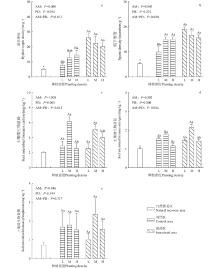
Fig.5
the soil hyphal length density(a),spore number (b)and the soil microbial biomass carbon (c), nitrogen(d)and phosphorus (e) Different uppercase letters represent significance between different mycorrhizal treatments; different lowercase letters represent significant difference between different planting density; * means significant difference between artificial reclamation area and natural recovery area(P<0.05). L, M, H respectively represents inoculated treatment, different planting density treatment, low planting density, intermediate planting density and high planting density."

Table 3
The root colonization of Hippophae rhamnoides in different mycorrhizal and planting density treatment"
| 处理 Treatment | 根系菌根侵染率 Mycorrhizal colonization frequency (%) | 根系菌根侵染密度 Mycorrhizal colonization intensity (%) | 根系丛枝丰富度 Arbuscule Abundance (%) | |
| 对照区Control area | 低Low | 86±5.13Bb | 17.67±1.10Bb | 0.01±0.01Bb |
| 中Intermediate | 98±2.89Aa | 27.04±1.63Ba | 0.00±0.00Bb | |
| 高High | 100±0.00Aa | 27.18±0.48Ba | 0.12±0.03Ba | |
| 接菌区Inoculated area | 低Low | 100±0.00Aa | 22.56±0.89Ac | 0.32±0.04Ac |
| 中Intermediate | 100±0.00Aa | 33.92±1.88Ab | 0.63±0.03Ab | |
| 高High | 100±0.00Aa | 43.97±1.51Aa | 4.34±1.14Aa | |
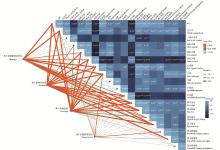
Fig.6
the Mantel’s test between understory vegetation and soil properties *** indicates significant correlation between two environmental variables at P<0.001 level, ** means significant correlation between two environmental variables at P<0.01 and * means significant correlation between two environmental variables at P<0.05."

Table 4
Comprehensive score and ranking of vegetation diversity and soil improvement with different mycorrhizal and planting diversity treatments"
| 处理 Treatment | 第1 主成分 PC1 | 第2 主成分 PC2 | 第3 主成分 PC3 | 第4 主成分 PC4 | 第5 主成分 PC5 | 综合得分 Comprehensive score | 排名 Rank | |
| 对照区 Control area | 低 Low | ?1.747 | 2.204 | ?0.539 | ?0.388 | ?0.969 | ?0.766 | 6 |
| 中等 Intermediate | 2.490 | 1.731 | 0.152 | ?0.713 | ?0.094 | 1.708 | 2 | |
| 高 High | 0.280 | ?2.064 | ?0.967 | ?0.569 | 0.906 | ?0.292 | 5 | |
| 接菌区 Inoculated area | 低 Low | 0.966 | ?1.687 | 1.634 | 0.871 | ?0.847 | 0.440 | 4 |
| 中等 Intermediate | 3.230 | 1.114 | 0.789 | 0.732 | 1.206 | 2.284 | 1 | |
| 高 High | 2.095 | ?1.112 | ?1.461 | 0.183 | ?0.672 | 0.838 | 3 | |
| 自然恢复区 Natural recovery area | ?7.454 | ?0.173 | 0.392 | ?0.116 | 0.471 | ?4.292 | 7 | |
| 鲍士旦. 2000. 土壤农化分析.3版. 北京: 中国农业出版社. | |
| Bao S D. 2000. Soil and agricultural chemistry analysis.3rd ed. Beijing: Chinese Agriculture Press.[in Chinese] | |
| 毕银丽. 丛枝菌根真菌在煤矿区沉陷地生态修复应用研究进展. 菌物学报, 2017, 36 (7): 800- 806. | |
| Bi Y L. Research advance of application of arbuscular mycorrhizal fungi to ecological remediation in subsided land of coal mining areas. Mycosystema, 2017, 36 (7): 800- 806. | |
| 毕银丽, 郭 晨, 王 坤. 煤矿区复垦土壤的生物改良研究进展. 煤炭科学技术, 2020, 48 (4): 52- 59. | |
| Bi Y L, Guo C, Wang K. Research progress of biological improvement of reclaimed soil in coal mining area. Coal Science and Technology, 2020, 48 (4): 52- 59. | |
| 毕银丽, 申慧慧. 西部采煤沉陷地微生物复垦植被种群自我演变规律. 煤炭学报, 2019, 44 (1): 307- 315. | |
| Bi Y L, Shen H H. Effect of micro–reclamation on different planted forest on the vegetation self-succession in the western mining subsidence area. Journal of China Coal Society, 2019, 44 (1): 307- 315. | |
| 毕银丽, 薛子可. 丛枝菌根真菌提高植物高温胁迫抗逆性及在矿区生态修复应用展望. 中国科学基金, 2021, 35 (6): 933- 939. | |
| Bi Y L, Xue Z K. Effects of arbuscular mycorrhizal fungi on resistance of plants to high temperature stress and application prospect of ecological restoration in mine area. Bulletin of National Natural Science Foundation of China, 2021, 35 (6): 933- 939. | |
| 丁继伟, 张芸香, 郭跃东, 等. 2018. 华北落叶松天然林密度对林下植被物种组成和多样性的影响研究. 西北林学院学报, 33(4): 10–16. | |
| Ding J W, Zhang Y X, Guo Y D, et al. 2018. Influences of the density on understory species composition and diversity of Larix principis-rupprechtii natural forest. Journal of Northwest Forestry University, 33(4): 10–16.[in Chinese] | |
|
丁 凯, 张毓婷, 张俊红, 等. 不同密度杉木林对林下植被和土壤微生物群落结构的影响. 植物生态学报, 2021, 45 (1): 62- 73.
doi: 10.17521/cjpe.2020.0158 |
|
|
Ding K, Zhang Y T, Zhang J H, et al. Effects of Chinese fir plantations with different densities on understory vegetation and soil microbial community structure. Chinese Journal of Plant Ecology, 2021, 45 (1): 62- 73.
doi: 10.17521/cjpe.2020.0158 |
|
| 董 哲, 魏天兴, 石 鑫, 等. 两种不同生长状况沙棘根系分泌物差异分析. 四川农业大学学报, 2012, 30 (2): 195- 200. | |
| Dong Z, Wei T X, Shi X, et al. Main compounds variations of root exudates in Hippophae rhamnoides with different growth states . Journal of Sichuan Agricultural University, 2012, 30 (2): 195- 200. | |
| 范军波, 夏静芳, 袁成平. 毛乌素沙地人工种植沙棘及管理经验浅谈. 国际沙棘研究与开发, 2008, 6 (3): 28- 30. | |
| Fan J B, Xia J F, Yuan C P. Study and experiences on seabuckthorn plantation and management in mu us sandy land. The Global Seabuckthorn Research and Development, 2008, 6 (3): 28- 30. | |
| 谷振军, 刘 倩, 曾纪孟, 等. 马尾松人工林密度控制对林下植被多样性的影响. 森林与环境学报, 2021, 41 (5): 504- 509. | |
| Gu Z J, Liu Q, Zeng J M, et al. Effects of density management on understory plant diversity in plantation forests of Pinus massoniana . Journal of Forest and Environment, 2021, 41 (5): 504- 509. | |
| 郭连金. 2005. 黄土丘陵区沙棘和小叶杨人工林群落稳定性研究. 杨凌: 西北农林科技大学. | |
| Guo L J. 2005. Study on the community stability of Hippophae rhamnoide and Populus simonii plantations in hilly-gully region of loess plateau. Yangling: Northwest A & F University.[in Chinese] | |
| 江飞焰. 2019. AM 真菌生物量及其对植物磷营养贡献的田间原位研究方法的建立. 北京: 中国农业大学. | |
| Jiang F Y. 2019. A method to evaluate arbuscular mycorrhizal fungal biomass and their contribution to maize phosphorus nutrition in situ in the field. Beijing: china agriculatral university.[in Chinese] | |
| 金 锁, 毕浩杰, 刘 佳, 等. 林分密度对云顶山柏木人工林群落结构和物种多样性的影响. 北京林业大学学报, 2020, 42 (1): 10- 17. | |
| Jin S, Bi H J, Liu J, et al. Effects of stand density on community structure and species diversity of Cupressus funebris plantation in Yunding Mountain, southwestern China . Journal of Beijing Forestry University, 2020, 42 (1): 10- 17. | |
| 李婷婷, 唐永彬, 周润惠, 等. 云顶山不同人工林林下植物多样性及其与土壤理化性质的关系. 生态学报, 2021, 41 (3): 1168- 1177. | |
| Li T T, Tang Y B, Zhou R H, et al. Understory plant diversity and its relationship with soil physicochemical properties in different plantations in Yunding Mountain. Acta Ecologica Sinica, 2021, 41 (3): 1168- 1177. | |
|
马克平, 黄建辉, 于顺利, 等. 北京东灵山地区植物群落多样性的研究Ⅱ丰富度、均匀度和物种多样性指数. 生态学报, 1995, 15 (3): 268- 277.
doi: 10.3321/j.issn:1000-0933.1995.03.006 |
|
|
Ma K P, Huang J H, Yu S L, Chen L Z. Plant community diversity in Dongling mountain, Beijing, China Ⅱ. Species richness, evenness and species diversities. Acta Ecologica Sinica, 1995, 15 (3): 268- 277.
doi: 10.3321/j.issn:1000-0933.1995.03.006 |
|
| 舒韦维, 卢立华, 李 华, 等. 林分密度对杉木人工林林下植被和土壤性质的影响. 生态学报, 2021, 41 (11): 4521- 4530. | |
| Shu W W, Lu L H, Li H, et al. Effects of stand density on understory vegetation and soil properties of Cunninghamia lanceolata plantation . Acta Ecological Sinica, 2021, 41 (11): 4521- 4530. | |
| 孙迎涛, 岳艳鹏, 成 龙, 等. 毛乌素沙地油蒿(Artemisia ordosica)生长及生物量分配对沙漠化的响应 . 中国沙漠, 2022, 42 (1): 123- 133. | |
| Sun Y T, Yue Y P, Cheng L, et al. Responses of growth and biomass allocation of Artemisia ordosica to desertification in Mu Us Sandyland . Journal of Desert Research, 2022, 42 (1): 123- 133. | |
| 田祥珅, 郑重谊, 刘勇军, 等. 稻作烟区土壤电导率和阳离子交换量的垂直分布特征与养分有效性的关系. 西南农业学报, 2021, 34 (12): 2700- 2706. | |
| Tian X S, Zeng Z Y, Liu Y J, et al. Vertical distribution of electrical conductivity and cation exchange capacity in soil and their relationship with nutrient availability in rice-growing tobacco areas. Southwest China Journal of Agricultural Sciences, 2021, 34 (12): 2700- 2706. | |
| 王 瑾, 毕银丽, 邓穆彪, 等. 丛枝菌根对采煤沉陷区紫穗槐生长及土壤改良的影响. 科技导报, 2014, 32 (11): 26- 32. | |
| Wang J, Bi Y L, Deng M B, et al. Effects of arbuscular mycorrhiza on growth of Amorpha fruticosa L. and soil improvement in coal mining subsidence area . Science & Technology Review, 2014, 32 (11): 26- 32. | |
| 魏 静, 杨 珂, 董起广. 不同检测方法对判断土壤机械组成的影响. 西部大开发(土地开发工程研究), 2020, 5 (2): 68- 72. | |
| Wei J, Yang K, Dong Q G. The influence of different detection methods on the determination of soil mechanical composition. Land Development and Engineering Research, 2020, 5 (2): 68- 72. | |
| 吴金水, 林启美, 黄巧云, 等. 2006. 土壤微生物生物量测定方法及其应用. 北京: 气象出版社. | |
| Wu J S, Lin Q M, Huang Q Y, et al. 2006. Determination methods and its applications of soil microbial biomass. Beijing: China Meteorological Press.[in Chinese] | |
|
悦飞雪, 李继伟, 王艳芳, 等. 生物炭和AM真菌提高矿区土壤养分有效性的机理. 植物营养与肥料学报, 2019, 25 (8): 1325- 1334.
doi: 10.11674/zwyf.18511 |
|
|
Yue F X, Li J W, Wang Y F, et al. Mechanism of the improvement effect by biochar and AM fungi on the availability of soil nutrients in coal mining area. Journal of Plant Nutrition and Fertilizers, 2019, 25 (8): 1325- 1334.
doi: 10.11674/zwyf.18511 |
|
| 张爱梅, 殷一然, 孙 坤. 沙棘属植物弗兰克氏菌研究进展. 微生物学通报, 2020, 47 (11): 3933- 3944. | |
| Zhang A M, Yin Y R, Sun K. Research progress in Frankia spp. associated with Hippophae L . Microbiology China, 2020, 47 (11): 3933- 3944. | |
| 张柳桦, 齐锦秋, 李婷婷, 等. 林分密度对新津文峰山马尾松人工林林下物种多样性和生物量的影响. 生态学报, 2019, 39 (15): 5709- 5717. | |
| Zhang L H, Qi J Q, Li T T, et al. Effects of stand density on understory plant diversity and biomass in a Pinus massoniana plantation in Wenfeng Mountain, Xinjin County . Acta Ecologica Sinica, 2019, 39 (15): 5709- 5717. | |
| 张 筱, 陈义堂, 杨秋菊, 等. 不同地形100年生杉木人工林土壤理化性质及林下植被多样性差异分析. 西南林业大学学报(自然科学), 2021, 41 (6): 60- 70. | |
| Zhang X, Chen Y T, Yang Q J, et al. Differences of soil physicochemical properties and undergrowth vegetation diversity of 100-year-old Chinese fir plantations in different terrain. Journal of Southwest Forestry University (Natural Sciences), 2021, 41 (6): 60- 70. | |
| 张勇强, 李智超, 厚凌宇, 等. 林分密度对杉木人工林下物种多样性和土壤养分的影响. 土壤学报, 2020, 57 (1): 239- 250. | |
| Zhang Y Q, Li Z C, Hou L Y, et al. Effects of stand density on understory species diversity and soil nutrients in Chinese fir plantation. Acta Pedologica Sinica, 2020, 57 (1): 239- 250. | |
|
Ares A, Neill A R, Puettmann K J. Understory abundance, species diversity and functional attribute response to thinning in coniferous stands. Forest Ecology and Management, 2010, 260 (7): 1104- 1113.
doi: 10.1016/j.foreco.2010.06.023 |
|
| Brundrett M, Bougher N, Dell B, et al. 1996. Working with mycorrhizas in forestry and agriculture. Canberra, Australia: Australian Centre for International Agricultural Research (ACIAR). | |
| Carr C A, Krueger W C. Understory vegetation and ponderosa pine abundance in eastern Oregon. Rangeland Ecology & Management, 2011, 64 (5): 533- 542. | |
|
Fredericksen T S, Agramont A R E. Regeneration patterns of Eastern white pine (Pinus strobus L.) in hardwood-dominated forests in Virginia, USA . New Forests, 2013, 44 (1): 51- 61.
doi: 10.1007/s11056-011-9300-x |
|
|
Jenkinson D S, Brookes P C, Powlson D S. Measuring soil microbial biomass. Soil Biology and Biochemistry, 2004, 36 (1): 5- 7.
doi: 10.1016/j.soilbio.2003.10.002 |
|
|
Kiers E T, Duhamel M, Beesetty Y, et al. Reciprocal rewards stabilize cooperation in the mycorrhizal symbiosis. Science, 2011, 333 (6044): 880- 882.
doi: 10.1126/science.1208473 |
|
|
Smith S E, Dickson S. Quantification of active vesicular-arbuscular mycorrhizal infection using image analysis and other techniques. Functional Plant Biology, 1991, 18 (6): 637.
doi: 10.1071/PP9910637 |
|
| Smith S E, Read D J. 1983. Mycorrhizal symbiosis. London: Academic Press. | |
|
Zhang L, Xu M G, Liu Y, et al. Carbon and phosphorus exchange may enable cooperation between an arbuscular mycorrhizal fungus and a phosphate-solubilizing bacterium. New Phytologist, 2016, 210 (3): 1022- 1032.
doi: 10.1111/nph.13838 |
| Viewed | ||||||
|
Full text |
|
|||||
|
Abstract |
|
|||||